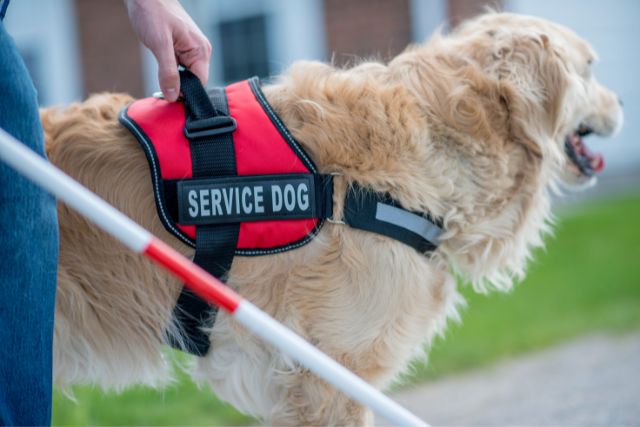Service dogs and emotional support animals both provide crucial assistance to individuals, but their roles, training, and legal recognition differ significantly.
This comprehensive guide will delve into these differences to help you understand their unique purposes and the laws governing them in Australia.
Introduction
Dogs have long been known as man’s best friend, but for many people, they are much more than that.
Service dogs and emotional support animals (ESAs) play critical roles in the lives of those with disabilities and mental health conditions.
Understanding the differences between these two types of support animals is essential for ensuring they receive the proper care, training, and recognition.
What Are Service Dogs?
Service dogs are specially trained to perform tasks that assist individuals with disabilities.
These tasks are directly related to the person’s disability and are designed to help them lead more independent lives.
Service dogs are protected under the Disability Discrimination Act 1992 in Australia, granting them full public access rights.

Definition and Purpose
Service dogs are defined as working animals that are trained to perform specific tasks for people with disabilities.
These tasks can range from guiding individuals who are visually impaired to alerting those with hearing impairments to important sounds, such as alarms or doorbells.
The primary purpose of a service dog is to assist their handler in daily life, helping them navigate challenges posed by their disabilities.
Types of Service Dogs
There are several types of service dogs, each trained to assist with different types of disabilities.
Understanding the variety of service dogs can help clarify their specific roles and the essential tasks they perform.
Guide Dogs
Guide dogs, also known as seeing-eye dogs, assist individuals who are blind or visually impaired.
These dogs help their handlers navigate obstacles, cross streets safely and perform other tasks that require vision.
Guide dogs are usually Labrador Retrievers or Golden Retrievers due to their intelligence and temperament.
Hearing Dogs
Hearing dogs are trained to assist individuals who are deaf or hard of hearing. They alert their handlers to important sounds, such as doorbells, alarms, or a crying baby.
These dogs often use physical touch, like nudging or pawing, to get their handler’s attention.
Mobility Assistance Dogs
Mobility assistance dogs help individuals with physical disabilities that affect their mobility. These dogs can retrieve items, open doors, and even assist with balance and stability.
They are particularly beneficial for individuals who use wheelchairs or have other mobility challenges.
Medical Alert Dogs
Medical alert dogs are trained to detect and respond to medical conditions.
For instance, diabetes-alert dogs can sense changes in blood sugar levels, while seizure alert dogs can predict and respond to epileptic seizures.
These dogs provide critical assistance by alerting their handlers to take necessary actions or seek help during emergencies.
Psychiatric Service Dogs
Psychiatric service dogs assist individuals with mental health conditions such as PTSD, anxiety, and depression.
They are trained to perform tasks like interrupting panic attacks, reminding handlers to take medication, and providing grounding during emotional distress.
What Are Emotional Support Animals?
Emotional support animals (ESAs) provide comfort and companionship to individuals dealing with mental health issues.
Unlike service dogs, ESAs do not require specific training to perform tasks related to a disability. Their primary function is to offer emotional support through their presence.

Definition and Purpose
Emotional support animals are pets that provide therapeutic benefits to their owners through companionship.
These animals help alleviate symptoms of anxiety, depression, and other mental health conditions.
Although ESAs are beneficial for emotional well-being, they do not have the same legal protections or training requirements as service dogs.
Types of Emotional Support Animals
While dogs are the most common type of ESA, other animals, such as cats, birds, and even rabbits, can also serve as emotional support animals.
The key factor is the bond between the animal and its owner, which provides comfort and emotional stability.
Key Differences Between Service Dogs and Emotional Support Animals
Understanding the key differences between service dogs and emotional support animals is crucial for recognizing their distinct roles and the legal implications of each.
Legal Recognition
Service dogs are legally recognized under the Disability Discrimination Act 1992 in Australia, granting them full public access rights.
This means they can accompany their handlers in public places, such as restaurants, stores, and public transport.
Emotional support animals, however, do not have legal recognition or public access rights, limiting their presence to pet-friendly areas only.
Training Requirements
Service dogs undergo extensive training to perform specific tasks related to their handler’s disability.
This training ensures that the dogs can perform their duties reliably and behave appropriately in public settings.
Emotional support animals, on the other hand, do not require any specialized training beyond basic obedience, as their primary role is to provide companionship.

Public Access Rights
Service dogs have full public access rights, meaning they can accompany their handlers into any public space.
These rights are protected under federal law to ensure that individuals with disabilities can lead independent lives.
Emotional support animals do not have public access rights, restricting their presence to places where pets are allowed.
Roles and Responsibilities
The roles of service dogs and emotional support animals are distinct.
Service dogs perform specific tasks that their handlers cannot do independently due to their disabilities. These tasks are essential for the handler’s daily functioning and safety.
Emotional support animals provide emotional comfort and companionship, which can help alleviate symptoms of mental health conditions but do not perform specific tasks related to a disability.
Benefits to Owners
Both service dogs and emotional support animals offer significant benefits to their owners. Service dogs provide critical assistance with daily tasks, enhancing their handler’s independence and quality of life.
Emotional support animals offer companionship and emotional stability, which can improve their owner’s mental health and overall well-being.
Each type of animal plays a vital role in supporting their owner’s specific needs.
Legal Aspects of Service Dogs and Emotional Support Animals in Australia
The legal framework surrounding service dogs and emotional support animals in Australia is crucial for understanding their rights and limitations.
Disability Discrimination Act 1992
The Disability Discrimination Act 1992 (DDA) protects the rights of individuals with disabilities, including those who rely on service dogs.
Under the DDA, service dogs are granted full public access rights, allowing them to accompany their handlers in nearly all public spaces.
This legislation ensures that individuals with disabilities can lead independent and integrated lives.
Public Access Rights for Service Dogs
Service dogs are permitted to enter public places such as restaurants, shops, public transport, and hotels.
These rights are protected to ensure that individuals with disabilities can participate fully in society without discrimination.
The rigorous training service dogs undergo ensures they behave appropriately in various settings, maintaining the safety and comfort of the public.

Restrictions on Emotional Support Animals
Emotional support animals do not have the same legal protections as service dogs. They are not granted public access rights and can only accompany their owners in pet-friendly areas.
This limitation can restrict the owner’s ability to have their ESA with them in certain public spaces, highlighting the importance of understanding the different legal statuses of these animals.
NDIS and Assistance Animals
The National Disability Insurance Scheme (NDIS) may provide funding for assistance animals, including service dogs, if they meet specific criteria.
The animal must pass the Public Access Test and demonstrate that it provides essential support to the individual’s disability needs.
Emotional support animals are not covered by the NDIS, as they are not recognized as necessary aids for disabilities.
Training and Accreditation
Training and accreditation are critical components for service dogs to ensure they can perform their roles effectively and safely.
Training Programs for Service Dogs
Service dogs undergo extensive training programs, often lasting up to two years. These programs teach the dogs specific tasks related to their handler’s disability, such as guiding, alerting, or retrieving.
The training process also includes socialization and behaviour training to ensure the dogs can function in various public settings.
Accreditation Process
After completing their training, service dogs must pass an accreditation process, which includes the Public Access Test. This test assesses the dog’s behaviour, skills, and ability to assist their handler in public.
Only dogs that pass this test are granted public access rights, ensuring they can safely accompany their handlers in all public spaces.
Public Access Test (PAT)
The Public Access Test (PAT) evaluates a service dog’s ability to remain well-behaved and effective in public settings.
The test includes scenarios such as navigating crowded areas, ignoring distractions, and performing specific tasks on command.
Passing the PAT is essential for service dogs to gain and maintain their accreditation and public access rights.

Training for Emotional Support Animals
While emotional support animals do not require specialized training, basic obedience training is recommended to ensure they are well-behaved and manageable.
This training helps ESAs provide the best possible support to their owners through stable and positive behaviour.
How to Obtain a Service Dog or Emotional Support Animal
Acquiring a service dog or emotional support animal involves several steps, from determining eligibility to choosing the right animal and organization.
This section will guide you through the process of obtaining these valuable companions.
Eligibility Criteria
To qualify for a service dog, individuals must have a documented disability that significantly impacts their daily life.
This can include physical disabilities, sensory impairments, or mental health conditions. A healthcare provider’s recommendation is often required.
For emotional support animals, a mental health professional’s letter stating the need for the animal to alleviate symptoms of a mental health condition is necessary.
Application Process
The application process for obtaining a service dog typically involves several steps. First, applicants must complete an initial assessment to determine their needs and suitability for a service dog.
This may include interviews, medical evaluations, and home visits. Once approved, the applicant is placed on a waiting list, as training a service dog can take up to two years.
For emotional support animals, the process is simpler, usually involving obtaining the necessary documentation from a mental health professional and adopting the animal from a shelter or breeder.
Cost and Funding Options
Service dogs can be expensive, with costs ranging from $30,000 to $60,000, including training, veterinary care, and equipment.
Various organizations and charities may offer financial assistance or provide service dogs at reduced costs. The NDIS may also cover some expenses for eligible individuals.
Emotional support animals typically incur regular pet costs, such as adoption fees, food, and veterinary care, without additional specialized training expenses.
Organizations Providing Service Dogs
Several reputable organizations in Australia provide service dogs, including Assistance Dogs Australia, Guide Dogs Australia, and Smart Pups.
These organizations offer trained service dogs to individuals with disabilities and provide ongoing support and training for both the dogs and their handlers.

Organizations Providing Emotional Support Animals
While there are no specific organizations dedicated to emotional support animals, many animal shelters and rescue groups can help individuals find a suitable ESA.
Organizations like the RSPCA and Animal Welfare League Australia have a wide selection of animals available for adoption, and they can provide guidance on choosing an ESA.
Living with Service Dogs and Emotional Support Animals
Living with a service dog or emotional support animal requires commitment and understanding of the responsibilities involved.
This section covers daily care, health maintenance, training, and public etiquette for these animals.
Daily Care and Maintenance
Service dogs and emotional support animals require daily care, including feeding, exercise, grooming, and veterinary check-ups.
Service dogs may also need regular practice of their specific tasks to maintain their skills. Consistent routines and positive reinforcement are key to keeping these animals healthy and happy.
Health and Veterinary Care
Regular veterinary care is essential for both service dogs and emotional support animals. This includes vaccinations, parasite control, dental care, and routine check-ups.
It’s important to have a trusted veterinarian familiar with the needs of working animals to ensure they receive the best possible care.

Training and Re-certification
Service dogs must undergo ongoing training to maintain their skills and pass annual re-certification tests, such as the Public Access Test.
This ensures they continue to perform their tasks reliably and behave appropriately in public settings.
Emotional support animals benefit from basic obedience training to ensure they are well-behaved and manageable.
Public Etiquette and Awareness
When in public, it’s important to respect the roles of service dogs and emotional support animals. Service dogs should not be distracted or petted while working, as this can interfere with their tasks.
Owners should educate others about the roles and rights of these animals to foster understanding and respect.
Common Misconceptions
There are several misconceptions about service dogs and emotional support animals. Addressing these myths can help clarify their roles and legal rights.
Service Dogs vs. Therapy Dogs
Service dogs and therapy dogs are often confused, but they serve different purposes. Service dogs assist individuals with disabilities, performing specific tasks to aid their handlers.
Therapy dogs, on the other hand, provide comfort and support to people in various settings, such as hospitals, schools, and nursing homes.
Therapy dogs do not have the same legal protections or public access rights as service dogs.
Emotional Support Animals vs. Pets
While emotional support animals provide therapeutic benefits through companionship, they are legally considered pets.
Unlike service dogs, ESAs do not have public access rights and are not trained to perform specific tasks. Their primary role is to offer emotional comfort to their owners.
Myths About Public Access Rights
There are many myths about the public access rights of service dogs and emotional support animals. For example, some people believe that ESAs have the same rights as service dogs, which is not true.
Service dogs have full public access rights under the law, while ESAs are limited to pet-friendly areas.
Educating the public about these differences helps ensure compliance with laws and respect for both types of support animals.
Conclusion
Service dogs and emotional support animals play vital roles in supporting individuals with disabilities and mental health conditions.
Understanding the differences between them, including their training, legal rights, and roles, is essential for ensuring they receive the appropriate care and recognition.
By respecting their unique contributions, we can create a more inclusive and supportive environment for those who rely on these incredible animals.
Frequently Asked Questions (FAQs)
Here are some common questions about service dogs and emotional support animals to provide further clarity on this important topic.
What Rights Do Service Dog Owners Have in Australia?
Service dog owners in Australia have the right to be accompanied by their service dogs in all public places, including restaurants, shops, and public transport.
These rights are protected under the Disability Discrimination Act 1992.

Can Emotional Support Animals Fly with Their Owners?
Emotional support animals do not have the same legal rights as service dogs and are generally not permitted to fly in the cabin with their owners on Australian airlines.
However, some airlines may allow ESAs in the cabin on a case-by-case basis.
How Long Does It Take to Train a Service Dog?
Training a service dog can take up to two years, depending on the specific tasks they need to perform.
This training includes obedience, task-specific skills, and public access training to ensure they can work effectively in various environments.
What Are the Costs Involved in Owning a Service Dog?
Owning a service dog involves significant costs, including initial training fees, veterinary care, food, and equipment.
These costs can range from $30,000 to $60,000. Some organizations provide financial assistance or offer service dogs at reduced costs to eligible individuals.
Can Any Dog Be an Emotional Support Animal?
Any domesticated animal that provides comfort and support to its owner can be considered an emotional support animal, including dogs, cats, birds, and rabbits.
The key requirement is a letter from a mental health professional stating the need for the animal.
Additional Resources
For further information on service dogs and emotional support animals, the following resources are highly recommended.
Links to Relevant Organizations
Several organizations provide valuable information and support for individuals with service dogs and emotional support animals. These include:











